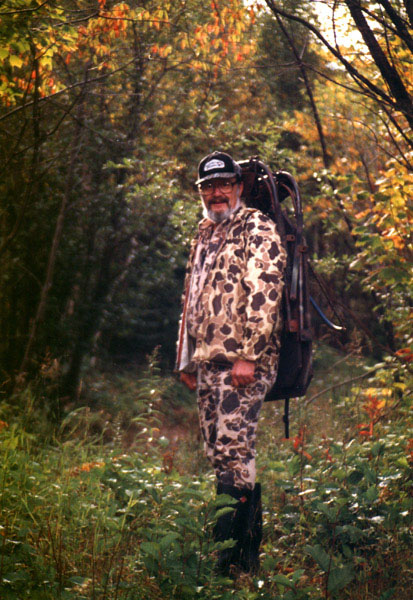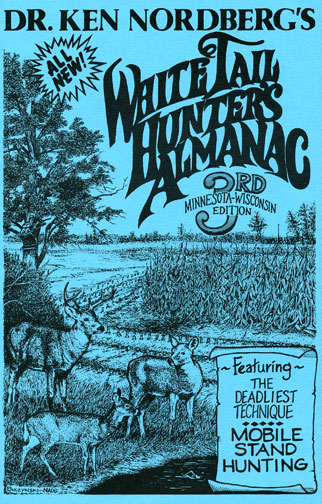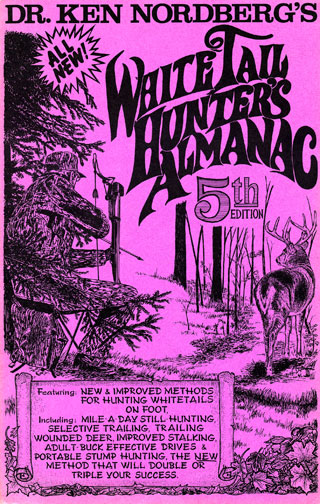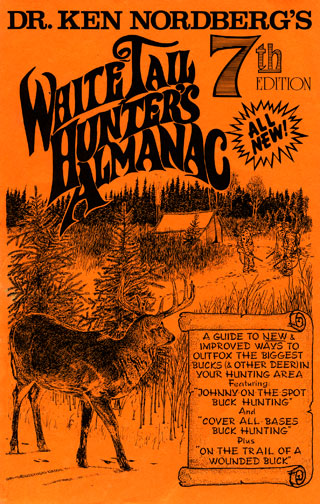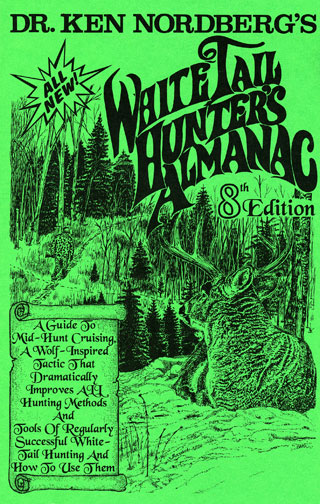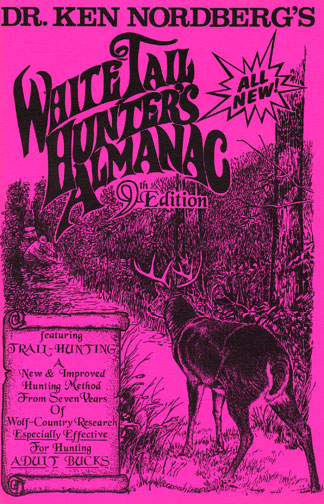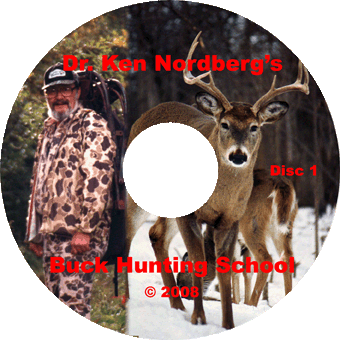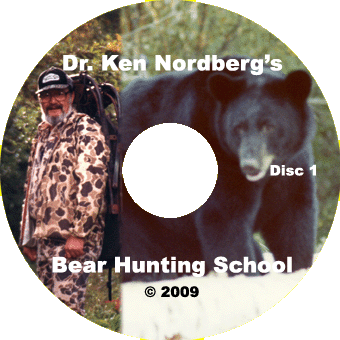Back to the Basics:
Whitetail Beds and Bedding Areas
By Dr. Ken Nordberg
The following is the another of many older articles that will appear on my website. This is article was first published in Midwest Outdoors in July of 1996. Please share what you learn from these articles with your whitetail hunting friends.
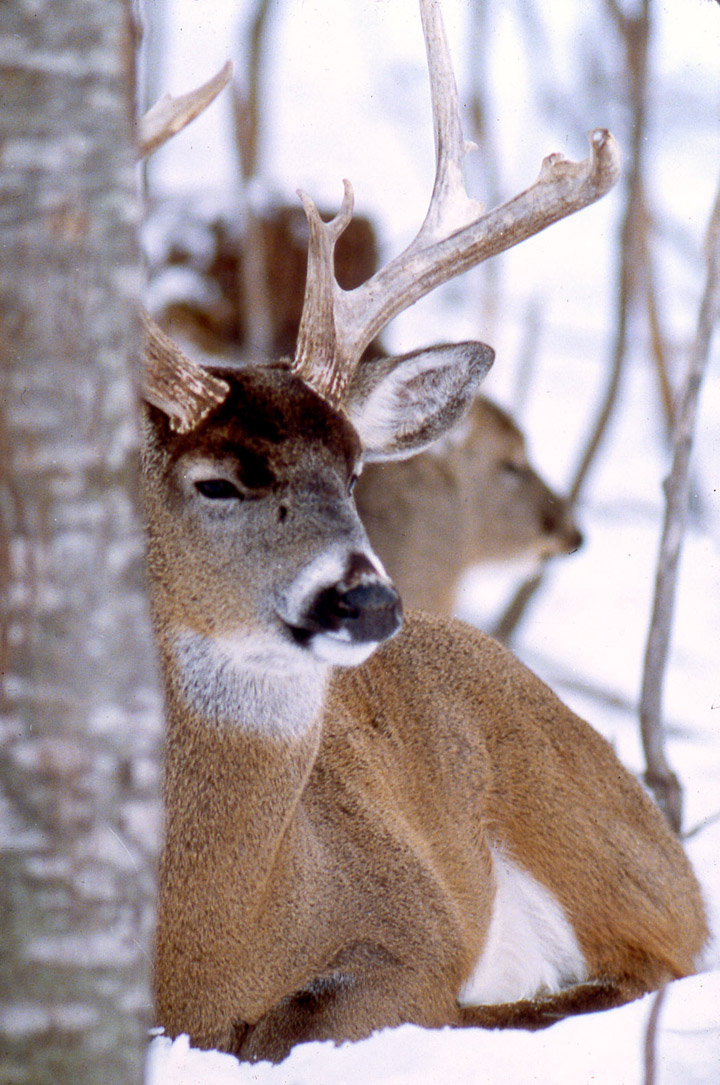
A beautiful, trophy-class whitetailed-buck in its bed.
During the legal shooting hours of any one day of a hunting season whitetails spend 4–6 hours in feeding areas and 4–6 hours in bedding areas. From September 1st through late December, whitetails feed in one or more of three feeding areas daily and locations of currently-favored feeding areas typically change in location every 2–3 weeks; every 1–3 days during hunting seasons where hunting pressure is moderate-to-great (where hunters are aggressive, constantly moving about and displaying obvious hunting behavior). If not invaded by hunters (whether inadvertent or by design), bedding areas, hubs of all whitetail activities, do not change location during hunting seasons. Nowhere within the vast ranges of whitetails are deer as predictable in location and time. Here, deer are likely to be spotted returning from feeding areas sometime between 9AM and 11AM or departing to feeding areas sometime between 2PM and an hour before sunset. While breeding is in progress, between 9–11AM and 2PM to one hour before sunset, the largest bucks of your hunting area, and maybe one or more lesser antlered bucks as well, are likely to be spotted trailing does in estrus restlessly wandering about their bedding areas. It should therefore be every serious hunter’s goal to be able to recognize the deer signs that identify whitetail bedding areas.
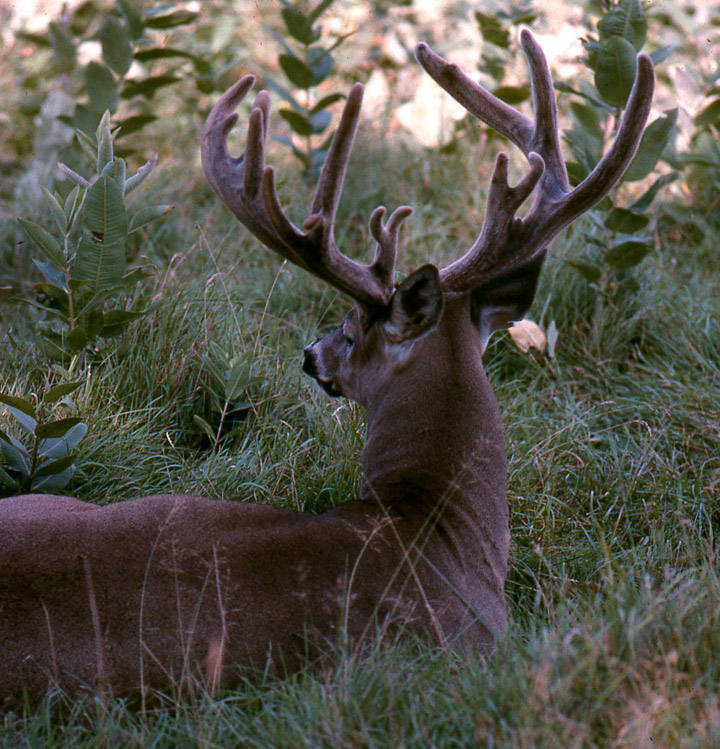
A beautiful, trophy-class whitetailed-buck, still in velvet, laying in grass.
Whether visible within grasses or other types of ground cover or on fallen leaves or snow, a whitetail bed, of course, is the quintessential sign of a bedding area. The trouble is, whitetails, especially adult bucks, do not always lie where their beds are easily discovered and/or discerned. Quite often it takes a combination of other deer signs plus knowledge of preferred bedding cover and terrain to identify whitetail bedding areas.
There are two kinds of whitetail bedding areas: 1) bedding areas of maternal does with young (doe families) and 2) bedding areas of adult bucks (2–7 years of age).
Doe family bedding areas, irregular in outline, are 10–40 acres in size. In forest areas they are typically found in mixed cover — checkerboards of trees ranging from saplings to mature timber and grassy openings. Maternal does prefer deep grasses for bedding, likely because it provides quick and effective cover for young fawns when threatened by marauding predators.
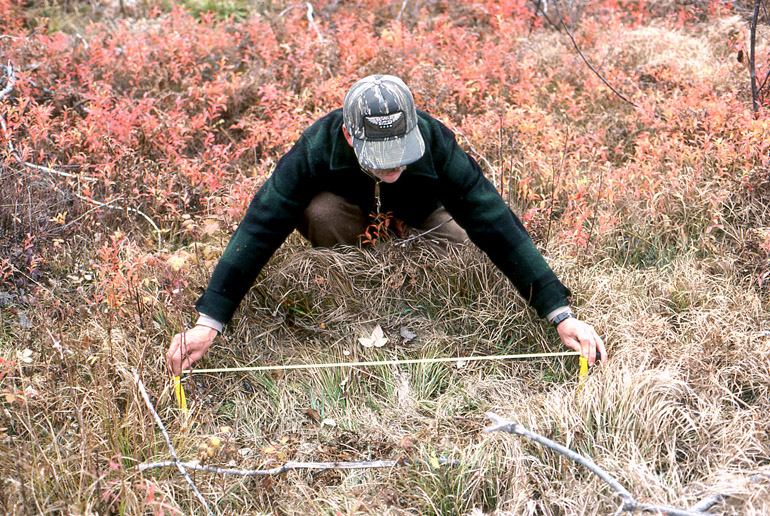
Doc recommends that you accurately measure whitetail beds.
In deep grasses beds of does and young (fawns and yearlings) are relatively easy to spot and measure. To avoid the accumulation of predator-attracting fawn scent, maternal does and their young rarely bed at the same site twice in a row, accounting for the larger size of doe family bedding areas. Farm country does and young commonly begin regularly bedding in fields of corn or other row crops as soon as they become deer-tall.

Doc is kneeling in snow by a larger deer's bed while pointing to a smaller deer's bed.
In deep grasses or on tilled soil of farm fields, beds that identify does and their young (fawns and yearlings) and their bedding areas are relatively easy to spot and measure. Throughout the northern tier of U.S. States, Iowa and Canada, fall beds of adult does and yearling bucks generally measure 40–42 inches in length, beds of yearling does, 38 inches in length and beds of fawns (depending on whether they were born in May, June or July) measure 30–36 inches in length.
Beds of a doe family are typically found within a few yards of one another, and be lengths easily identify the classes of deer that make up the group. A solitary (no other beds nearby) 42-inch bed in deep grass is generally that of a yearling buck. Yearling bucks commonly spend significant time away from their maternal does in fall and early winter, bedding, nonetheless, within the large bedding areas of their mothers.
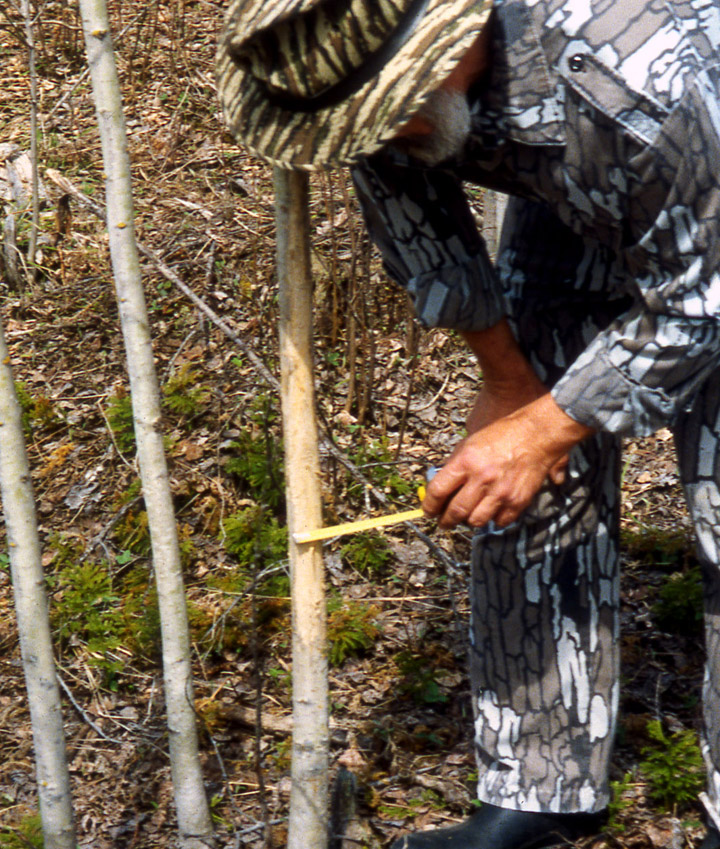
Doc is measuring a smaller antler rub, made by a young buck.
A few scattered yearling buck antler rubs on trees an inch or less in diameter are common within doe family bedding areas.
The first thing a whitetail does upon arising from its bed is empty its bowels. Accordingly, a characteristic of every whitetail bedding area, buck or doe, is abundant deer droppings, fresh and old. Notably abundant deer droppings (which also aide in identifying the deer that bed in any one area) are found in only two places in a whitetail’s home or breeding range — its bedding area or any of its favorite feeding areas. If beds are present, and obvious signs of feeding are present, it’s a feeding area. If beds are present, if cover and terrain are typical of a bedding area and if signs of feeding (or favored foods) are absent, it’s a bedding area.
Whether because adult bucks tend to be loners or because they want to minimize the need for rapid flight, hazardous to developing antlers, these deer select bedding areas with much greater caution or foresight than maternal does. Bedding areas of adult bucks, usually widely separated from bedding areas of does with young, are small, typically only 1–2 acres in size (sometimes as large as 10 acres). As a rule, buck bedding areas are located in secluded, out-of-the-way places in dense, woody, noisy cover where no sizable creature can stalk near without the buck hearing it. In mountainous or hilly regions, adult bucks typically bed high on a saddle or bench where they have a commanding view. Hilly or not, farm bucks also prefer bedding sites that offer a wide field of view, taking advantage of protection provided by open fields. Wherever bucks bed, a reliable, year-around source of water is almost always located within 200 yards and within a few jumps of an escape area of some kind — a large wooded swamp or steep, wooded slope, for example.
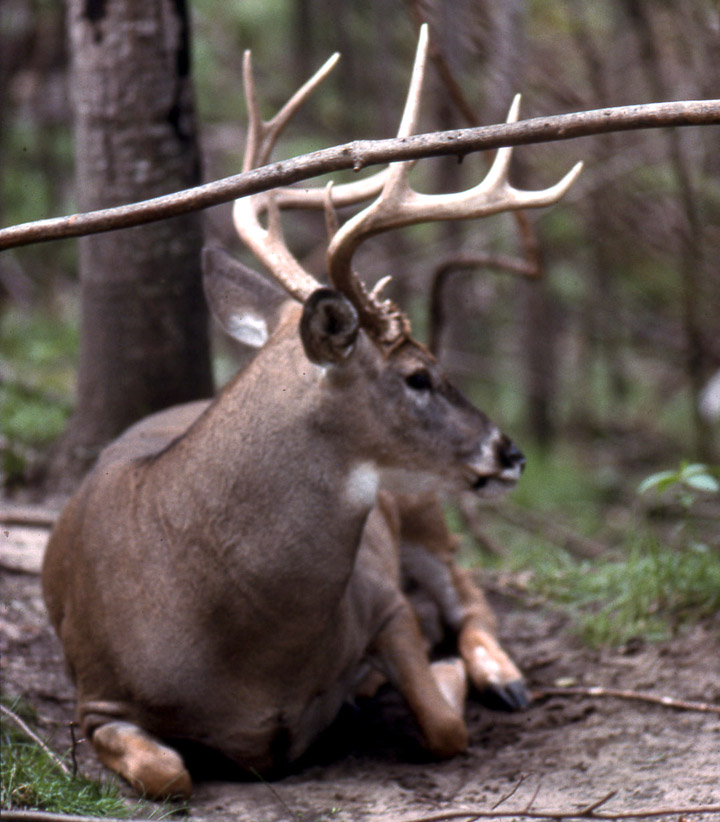
At ground level, in dense cover, there may not be a lot grasses or leaves. This can make it more difficult to find a dominant buck's bed.
Except while there is snow on the ground, buck beds are often difficult to discern and measure because of a relative lack of ground cover within the thick and woody cover of a buck bedding area.

Doc's rifle, "Big Boomer" laying in the snowy bed of a monster buck.
After snow covers the ground in northern U.S. States, Iowa and Canada, or where impressionable ground cover is present, a cluster of beds 45 inches, plus or minus an inch or two, identifies the bedding area of a 2-1/2 year-old buck; a cluster of beds 50–56 inches in length, the bedding area of a 3-1/2–6-1/2 year-old buck (56-inch beds are relatively rare).
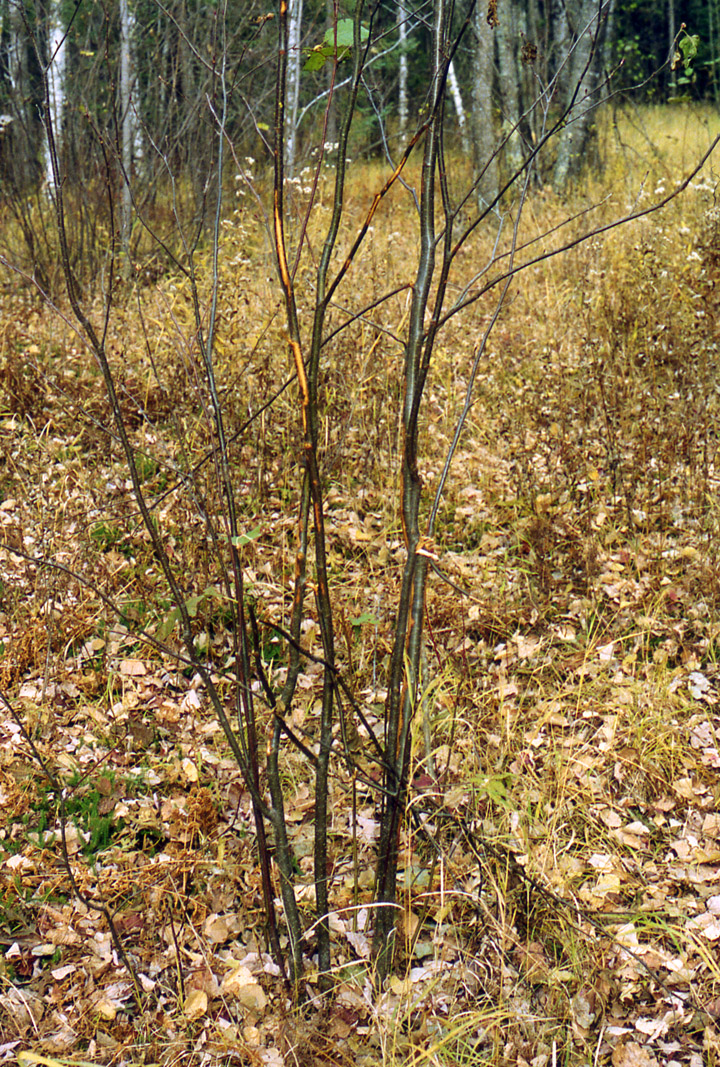
This is a velvet rub. Many hunters never spot them, or are not impressed by them. They are usually found in — or very near to — Buck Bedrooms, and thus, are very important finds.
Two kinds of easy-to-spot antler rubs, fresh or made during the previous fall, also identify buck bedding areas. One or two velvet rubs (sometimes more), generally made on willowy saplings about 1-inch in diameter in late August or early September, are almost always located within or very near buck bedding areas. During the 2–3 weeks before breeding begins (Rut Phase II), bucks 2-1/2 years of age make 6–30 rubs on bedding area trees predominantly 1-1/2–2-1/2 inches in diameter.
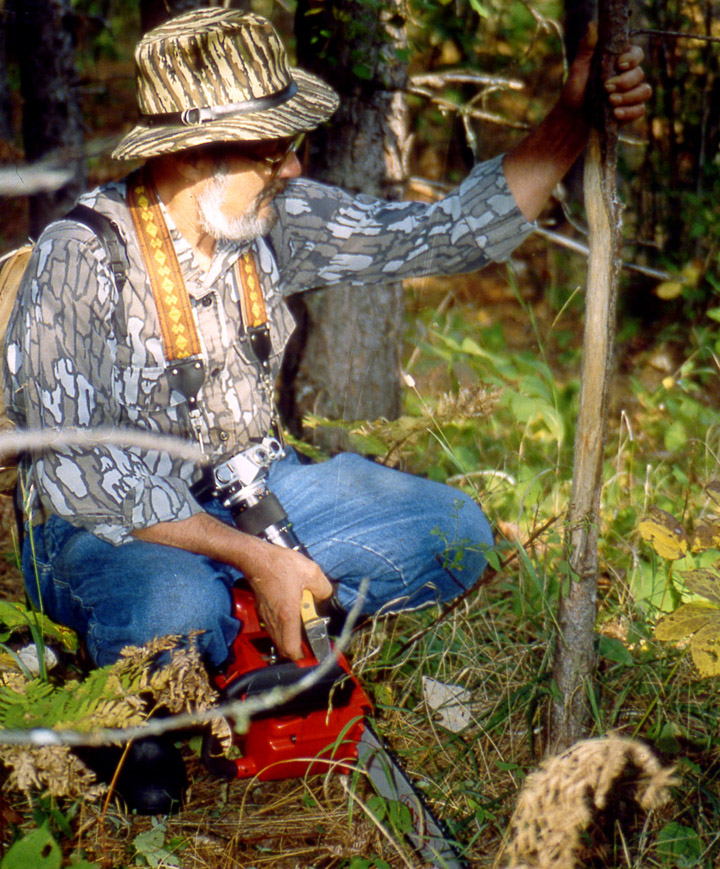
Doc next to a common-sized antler rub. This one is old — made during the previous fall. A cluster of these in a small area, in appropriate cover is a sign of a Buck Bedroom.
Bucks 3-1/2–6-1/2 years of age make rubs on trees predominantly 3–8 inches in diameter. Though clustered, these larger-diameter rubs may be fifty yards or so apart, so where you find one in a characteristic cover and terrain (near water), always take the time to search for other rubs or you may overlook an area of enormous hunting value.
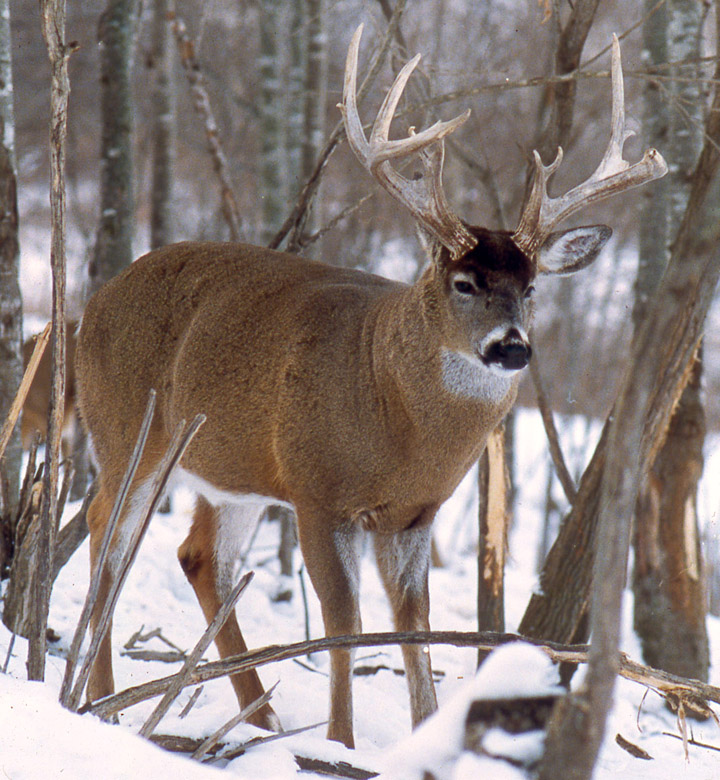
A beautiful, large white-tailed buck in its Buck Bedroom. Note all of the damage it has done to the trees.
Bedding areas of doe families are not usually crossed by more than 1–3 major deer trails, if any and bedding areas of adult bucks are not ordinarily crossed by any major deer trails. You are unlikely to find them if you stick to major deer trails while scouting. Bucks wisely avoid bedding where major trails are abundant because such trails are also much-used by large predators and man. Generally, too, whitetails move significant distances along previously untrod routes before lying down, thereby minimizing the amount of trail scent leading to their beds. Faint trails (minor) are relatively abundant within long-established bedding areas, however. Abundant off-trail tracks and droppings of varying ages commonly create the mistaken impression the area is loaded with deer. A doe family unit may share a nearby feeding area and/or watering spot with one or more adult bucks, but the bedding areas of doe family units and adult bucks are widely separated. Adult bucks only bed within doe family bedding areas while breeding is in progress. Adult bucks occasionally bed together (especially during Rut Phase IV) but their bedding areas, too, are usually 100–200 yards or more apart.
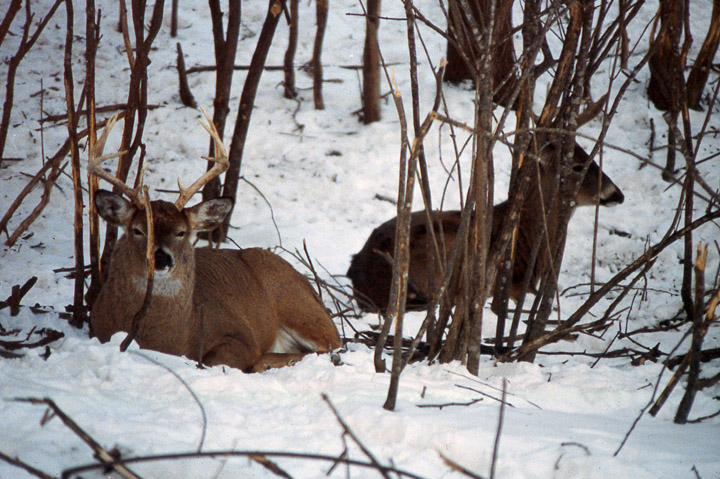
Two large bucks bedding together during Rut Phase IV — the recovery phase. Note the antler rubs.
Adult deer sometimes bed outside of established bedding areas — dominant bucks while maintaining scrapes during Rut Phase II (in large breeding ranges, 600–1,000 acres in size), lesser adult bucks while displaced off-range by dominant bucks during Rut Phases II and III, most adult bucks while breeding is in progress, all deer while feeding on special foods such as white oak acorns, fawns while waiting for their maternal does to finish eating in feeding areas, all deer, on occasion, while congregated in staging areas adjacent to open feeding areas and any deer forced to abandon their ranges during hunting seasons.
If you hunt south of the northern tier of U.S. States and Iowa, determine lengths of beds of the following five classes of whitetails in your hunting area by using the following formulas. Start with the bed measurement of an adult doe living in your hunting area — the largest of a cluster of doe family unit beds found in deep grasses. To make sure you do not start with the bed of a yearling doe, look for several clusters of beds that include fawn beds and then use the longest bed measurement.
Yearling buck bed (B) length (L) = adult doe bed length (ADBL)
Yearling doe BL = ADBL x 0.93
Fawn BL = ADBL x 0.81 to 0.85
2-1/2 year-old buck BL = ADBL x 1.10
3-1/2–6-1/2 year-old buck BL = ADBL x 1.22 to 1.32
Detailed instructions for hunting identified whitetail bedding areas will be presented later in this “Back to the Basics” series. Basically, however, here’s how you do it. Unless breeding is in progress, stay away from them until at least the last two days of your hunt. If you allow quarries to have safe places to bed, they’ll stay with you, maintaining normal, predictable habits in normal, predictable places throughout your hunt. Once you ruin the security of a bedding area, especially the bedding area of an adult buck, the deer will not only abandon its bedding area, perhaps forever, but its entire range, likely until the hunting season is over. If breeding is in progress, don’t hesitate to hunt (sit) downwind perimeters of doe family bedding areas. Always approach from 200 yards downwind, never cross a bedding area and never approach near enough to be easily spotted by a deer in the bedding area. Your goal should be to ambush your quarry while it is returning to or departing from its bedding area, not ambush it while it is bedded.
Next month: Antler Rubs.
Good Luck Hunting,
Doc
